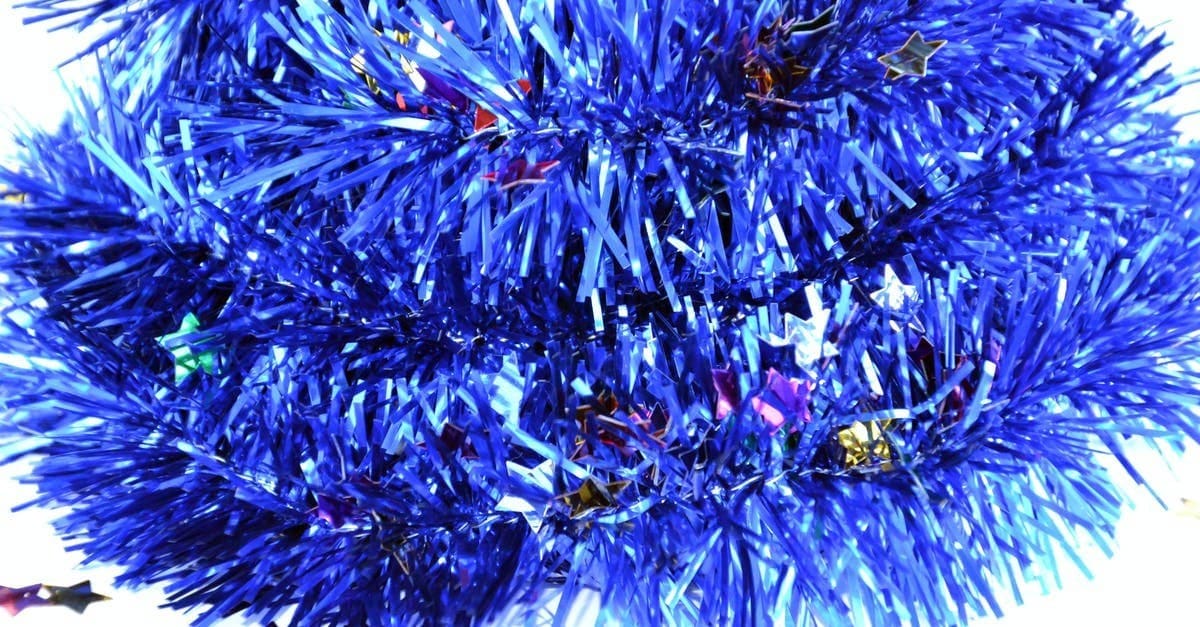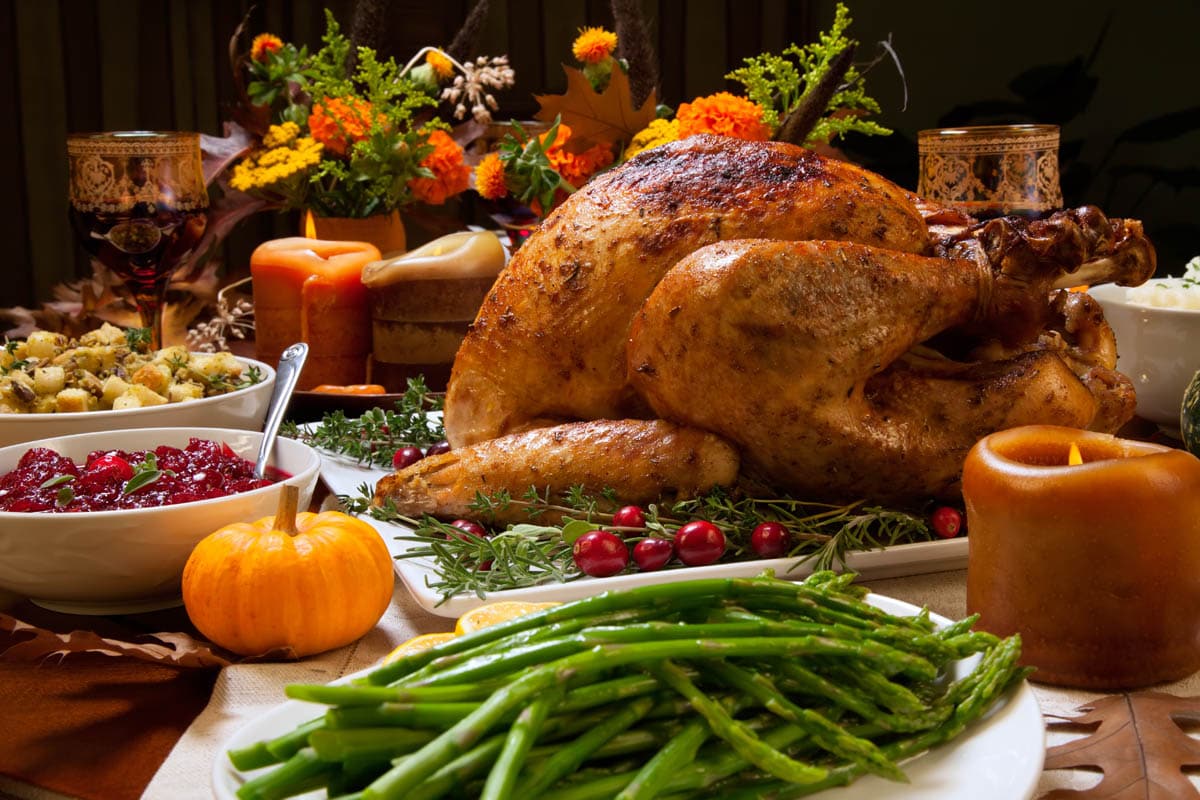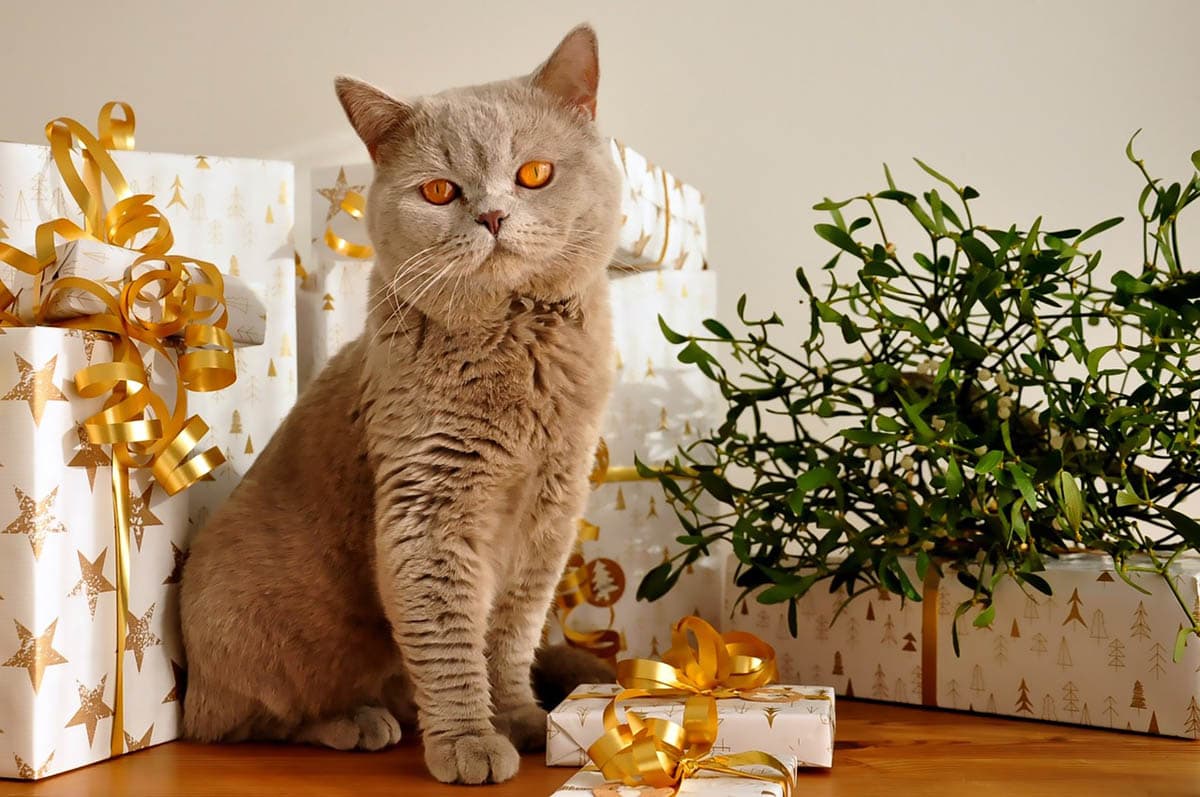At a glance
- Christmas trees
- Decorations and ribbons
- Christmas food (ham, cooked turkey bones, chocolate, turkey stuffing)
- Christmas plants and flowers
- Dangerous cat toys and clothing
- Batteries
- Guests
- Fireworks
Christmas decorations and ribbons

Angel hair or lametta tinsel (the long spaghetti-like strands) and decorative ribbons pose a threat to cats if ingested. These long strands (defined as linear foreign bodies) can cause plication of the intestines, a severe condition where one end of the object is anchored (usually to the tongue, or the exit of the stomach), and the remainder trails into the gastrointestinal tract. As the intestines attempt to move the tinsel along, they plicate which can lead to perforation, gastrointestinal obstruction and death to parts of the gastrointestinal tract.
Tinsel can cause gastrointestinal obstruction if the cat ingests a large amount.
Fake snow contains sodium polyacrylate is mildly toxic to cats, producing gastrointestinal signs, use sparingly if your cat shows an interest.
Avoid snow globes many of which contain antifreeze (see below, under winter).
Christmas flowers and plants
This time of year, I see so many people heading out to visit friends and relatives with flowers or plants. Many plants are listed as toxic, but levels of toxicity can range from life-threatening to mild gastrointestinal upset.
Common Christmas plants include:
- Mistletoe – Toxic
- Holly – Toxic
- Poinsettia – Mild toxicity
- Fir or pine – Non-toxic *
- Lily – Toxic
- Amaryllis – Toxic
While not especially tied to Christmas, lilies are a common flower in floral arrangements which are deadly to cats, causing acute kidney failure. If there is a cat in the house you are visiting (or if you have a cat yourself), keep lilies out of the house.
Live Christmas trees are generally non-toxic but do not let cats chew the needles which can potentially damage the gastrointestinal tract.
Christmas trees

Unplug Christmas lights from the socket when not supervised and apply bitter apple if your cat is prone to chewing on cords which can cause an electric shock and burns to the mouth.
Make sure that live trees receive enough water (daily) to reduce the number of needles the tree drops. Do not leave water sitting in a tray the cat can access and avoid the use of plant food or preservatives while the tree is inside as chemicals can cause toxicity.
Keep breakable decorations away from the bottom of the tree so the cat can’t knock them down. We use plastic baubles now to avoid the risk of glass injuries from broken decorations.
Don’t hang Christmas treats such as chocolate or candy canes on trees, or if you must, hang them up high.
Make sure the tree has a solid base to prevent it from being knocked over and try not to have the tree near furniture and or shelves which the cats can use to jump onto the tree.
How to cat-proof a Christmas tree
- Consider putting the tree up and leaving it bare for a few days so that the novelty of a new item in the house wears off. Once the cats are used to it being there, add decorations.
- Place the tree in a pot that has a good solid base so it won’t easily be knocked over by your cat. Try not to have the tree near furniture and or shelves which the cats can use to jump onto the tree.
- Keep valuable and breakable objects closer to the top of the tree where they can’t easily be reached by your cat.
- Properly secure breakable objects with wire hangers or twist ties.
- Place a Scat Mat under the tree. This mat either emits a static charge when stood on or emits a sound to deter your cat.
- Secure your tree by attaching some fishing wire to the top of the tree and attaching it to a ceiling hook.
- Try placing some orange or lemon peel around the base of the tree. Cats dislike the smell of citrus. Replace once or twice a week.
- If your cat is prone to nibbling on the branches, spray some bitter apple on the tree.
- Place some plastic carpet runner, turned upside down on the floor around the tree. Cats dislike the feel of this on their feet.
Christmas food

Who doesn’t love Christmas food? Ham, chocolate, and turkey are in plentiful supply, but when it comes to our cats, sharing is not caring.
Ham contains high levels of sodium which is not healthy for cats, and the high-fat content can cause pancreatitis, a painful inflammation of the pancreas, due to activation of digestive enzymes which begin to break it down.
Turkey meat without the skin is okay to give as a small treat, but don’t feed cooked turkey bones as they can splinter and cause damage to the gastrointestinal tract.
Do not give any turkey stuffing as it contains onions that are toxic to cats.
Chocolate is a no-no, as it contains theobromine and caffeine which are both toxic as well as high levels of fat which can cause pancreatitis — the darker the chocolate, the higher the toxicity.
Grapes and raisins are a known toxin to dogs, causing acute renal failure; they may be toxic to cats also with one reported case of toxicity. Cats are less likely to eat grapes or raisins than dogs; it is better to be safe than sorry and keep mince pies, Christmas cake, and pudding as well as fresh grapes away from your cat.
Winter dangers
Cats who live in the Northern Hemisphere are mid-winter over Christmas.
- Antifreeze – Antifreeze (ethylene glycol) is highly toxic to cats. Keep cats out of areas where antifreeze is stored, and immediately clean up any spills.
- Car engines – Cats who go outside will often curl up under the warm engine bonnet, which can be hazardous due to degloving injuries and severe burns. Tap the bonnet of the car before you start it.
Summer dangers
For cats living in the Southern Hemisphere, Christmas is in the middle of summer, which comes with risks.
- Heatstroke – Heatstroke is a condition caused by the body overheating and is most often associated with exposure to extreme temperatures. It has many catastrophic effects on the body.
- Snakes – Snakes are active in the warmer months and cats will attack if given the opportunity. Be diligent if you live in an area prone to snakes and ensure your garden and surrounds are free of debris and places snakes like to hide.
- Ticks – My cat’s veterinary practice keeps a tally of cases of tick poisoning in their waiting room, and it is alarming to see they treat over 30 cases a month (and this is a small town). If your cat goes outside, even in an enclosure, ensure you use a tick preventative and check your cat daily for ticks.
Pet toys and clothing
It may be cute to dress your cat up as Santa or an elf but take care and only ever dress a cat for a short period and under constant supervision.
Buy cat toys from reputable pet shops and suppliers and make sure there are no small parts that can easily be chewed and swallowed.
Batteries
Button batteries can come in a range of sizes. Most cats would not intentionally eat a battery, but an accidental ingestion can occur if a cat finds, and plays with a battery lying around. Ingestion can be fatal.
Guests and open doors
Guests themselves aren’t a danger, but non-cat-lovers aren’t always cat-savvy when it comes to closing external doors, leaving the potential for indoor cats to escape.
Most cats don’t like large crowds and lots of noise, provide a safe place for your cat to retreat to if you are having visitors over and remind children that when the cat is in their designated safe place, to leave the cat alone.
Make sure the cat is microchipped and that the microchip details are up to date so that if he does escape and ends up at a local shelter or veterinary practice, he can be quickly reunited with you.
Fireworks
New Year’s Eve fireworks can be stressful for pets. Loud bangs and sudden flashes of light can cause cats enormous stress and anxiety.
Block out fireworks noises by turning on the TV or radio for some background sound.
Close curtains and blinds when firework displays are on.
Keep your cat indoors on nights firework displays are on (such as New Year’s Eve, Guy Fawkes Night, Australia Day). Block off cat flaps and close windows.
Provide your cat with a place to hide, such as a cat carrier (we advise they be left out at all times), inside a wardrobe or quiet room.
Key points
- Try to stick with your cat’s regular diet during Christmas and the New Year period. A small amount of turkey or chicken won’t hurt but avoid other Christmas foods.
- Cats like routine and not all cats cope with a lot of visitors. Make a safe place where the cat can retreat (a bedroom that is out of bounds to guests for example).
- Keep your veterinarian’s number as well as an emergency/out of hours veterinarian in an easy to locate area such as the fridge.
- Select cat toys carefully; not all cat toys are safe for cats.
- Be careful when buying flowers or plants, or receiving flowers and plants as many are toxic to cats.

